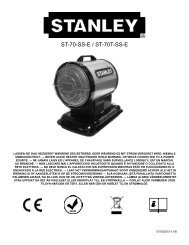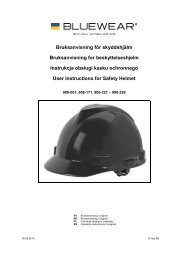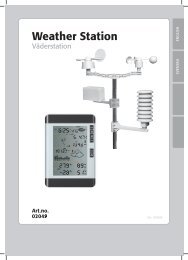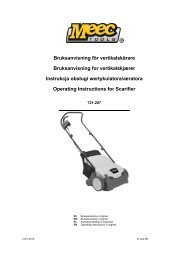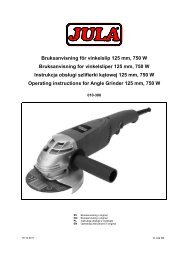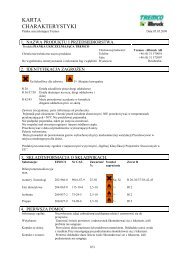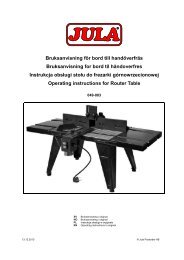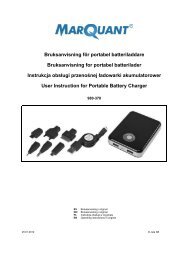Instrukcja obsługi (259.1 KB - pdf) - Jula
Instrukcja obsługi (259.1 KB - pdf) - Jula
Instrukcja obsługi (259.1 KB - pdf) - Jula
Create successful ePaper yourself
Turn your PDF publications into a flip-book with our unique Google optimized e-Paper software.
ENGLISH<br />
TYPE APPROVAL<br />
The product has been type approved by the accredited testing institute<br />
BTTG Testing & Certification Ltd.<br />
Manchester M17 1EH United Kingdom<br />
NB 0338, 0339<br />
USE<br />
EN 1149<br />
The garment should be used together with other garments that provide protection in accordance<br />
with EN 1149-5.<br />
Wearers of antistatic protective clothing must be properly earthed. The resistance from the wearer<br />
to earth should less than 108 Ω, for example, via suitable footwear.<br />
Parts of the body not protected by these must be protected in some other way. The garment must<br />
be closed when in use. Antistatic protective clothing should not be opened or taken off in the<br />
vicinity of flammable or explosive gases or when handling flammable or explosive substances.<br />
The electrically insulating effect in the protective garments is weakened by water, moisture and<br />
sweat.<br />
Antistatic protective garments should not be used in oxygen enriched air without being checked by<br />
a safety engineer.<br />
The antistatic effect of the protective garment can be influenced by wear, washing and fouling.<br />
Antistatic garments should when in normal use (even when the wearer is bending and moving)<br />
always cover all materials that do not meet the standard.<br />
EN ISO 11612<br />
The garment should be used together with other garments that provide protection in accordance<br />
with EN ISO 11612.<br />
Parts of the body not protected by these must be protected in some other way.<br />
The garment must be closed when in use.<br />
In the event of splashing from chemicals or flammable liquids onto the garment, the wearer should<br />
immediately move away and carefully take off the garment and make sure the chemicals or liquid<br />
do not come into contact with any part of the skin. The garment should then be washed or<br />
discarded.<br />
In the event of splashing from molten metal, the wearer should immediately leave the workplace<br />
and take off the garment.<br />
In the event of splashing from molten metal it is possible that the garment, if worn directly against<br />
the skin, will not eliminate the risk of burn injuries.<br />
A combination of garments receives the safety class that corresponds to the class for the garment<br />
with the lowest safety class.<br />
The garment has been tested for heat resistance, limited flame spread and heat transfer.<br />
CARE<br />
Follow the symbols in the washing instructions for the garment.<br />
Only use synthetic detergent, not detergent with soap.<br />
Keep the garment clean for maximum protective effect.<br />
The garment should be inspected after washing.<br />
The garment must only be repaired with fabric and thread that comply with the requirements for the<br />
garment standard.<br />
Protective clothing must provide protection during the entire period of use.<br />
The expected protection can be reduced for the following reasons:<br />
- moisture and mouldering (aging).<br />
- Chemicals, e.g. oil, solvents, acids<br />
- abrasion, fouling and damage resulting from use<br />
- incorrect storage and treatment (washing)<br />
- thermal effects<br />
16



